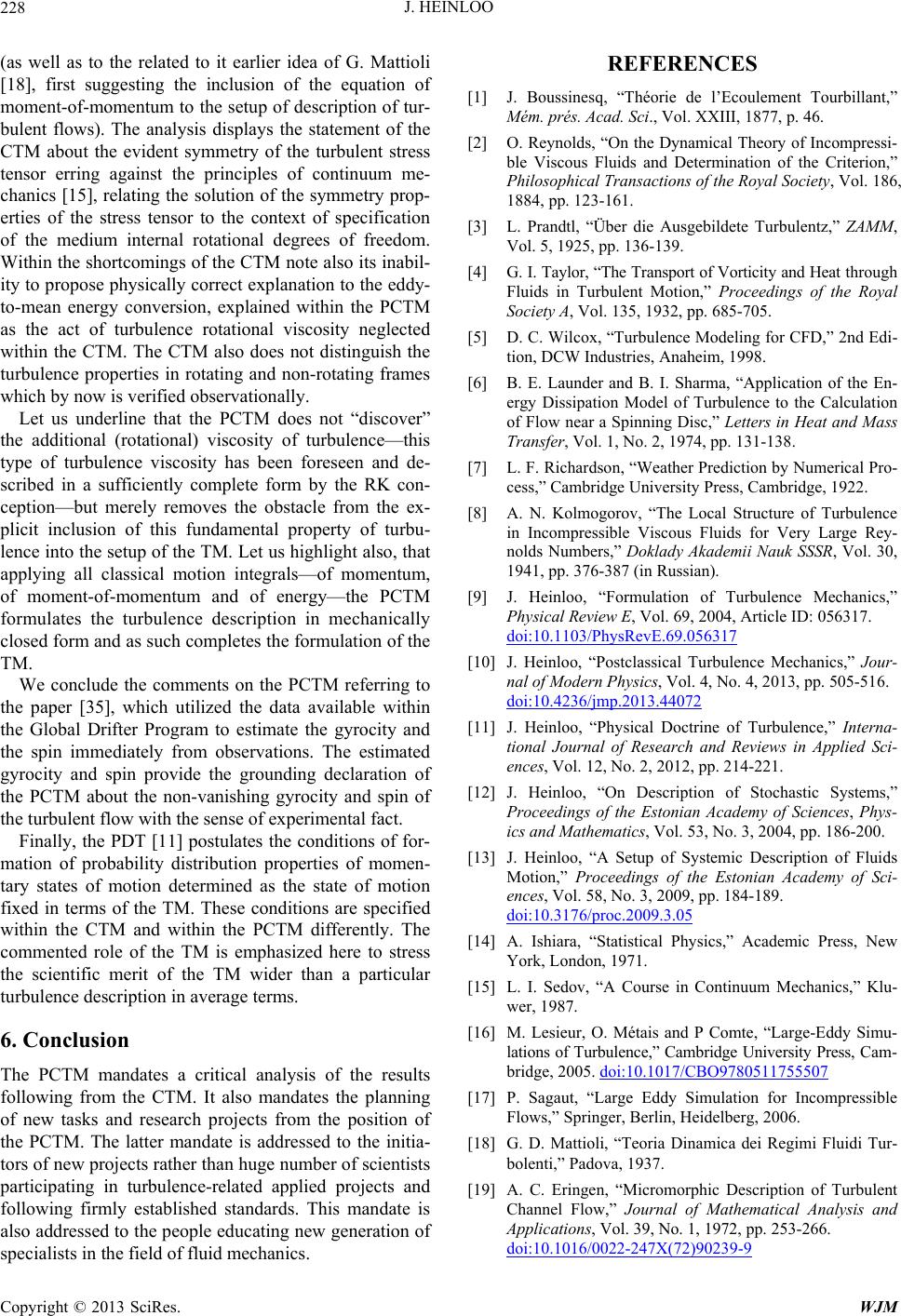
J. HEINLOO
228
(as well as to the related to it earlier idea of G. Mattioli
[18], first suggesting the inclusion of the equation of
moment-of-momentum to the setup of description of tur-
bulent flows). The analysis displays the statement of the
CTM about the evident symmetry of the turbulent stress
tensor erring against the principles of continuum me-
chanics [15], relating the solution of the symmetry prop-
erties of the stress tensor to the context of specification
of the medium internal rotational degrees of freedom.
Within the shortcomings of th e CTM note also its inabil-
ity to propose ph ysically correct explanation to the eddy-
to-mean energy conversion, explained within the PCTM
as the act of turbulence rotational viscosity neglected
within the CTM. The CTM also does not distinguish the
turbulence properties in rotating and non-rotating frames
which by now is verified observationally.
Let us underline that the PCTM does not “discover”
the additional (rotational) viscosity of turbulence—this
type of turbulence viscosity has been foreseen and de-
scribed in a sufficiently complete form by the RK con-
ception—but merely removes the obstacle from the ex-
plicit inclusion of this fundamental property of turbu-
lence into the setup of the TM. Let us highlight also, that
applying all classical motion integrals—of momentum,
of moment-of-momentum and of energy—the PCTM
formulates the turbulence description in mechanically
closed form and as such completes the formulation of the
TM.
We conclude the comments on the PCTM referring to
the paper [35], which utilized the data available within
the Global Drifter Program to estimate the gyrocity and
the spin immediately from observations. The estimated
gyrocity and spin provide the grounding declaration of
the PCTM about the non-vanishing gyrocity and spin of
the turbulent flow with the sense of experimental fact.
Finally, the PDT [11] postulates the conditions of for-
mation of probability distribution properties of momen-
tary states of motion determined as the state of motion
fixed in terms of the TM. These conditions are specified
within the CTM and within the PCTM differently. The
commented role of the TM is emphasized here to stress
the scientific merit of the TM wider than a particular
turbulence description in average terms.
6. Conclusion
The PCTM mandates a critical analysis of the results
following from the CTM. It also mandates the planning
of new tasks and research projects from the position of
the PCTM. The latter mandate is addressed to the initia-
tors of new projects rather than hug e number of scien tists
participating in turbulence-related applied projects and
following firmly established standards. This mandate is
also addressed to the people educating new generation of
specialists in the field of flu id mechanics.
REFERENCES
[1] J. Boussinesq, “Théorie de l’Ecoulement Tourbillant,”
Mém. prés. Acad. Sci., Vol. XXIII, 1877, p. 46.
[2] O. Reynolds, “On the Dynamical Theory of Incompressi-
ble Viscous Fluids and Determination of the Criterion,”
Philosophical Transactions of the Royal Society, Vol. 186,
1884, pp. 123-161.
[3] L. Prandtl, “Über die Ausgebildete Turbulentz,” ZAMM,
Vol. 5, 1925, pp. 136-139.
[4] G. I. Taylor, “The Transport of Vorticity and Heat through
Fluids in Turbulent Motion,” Proceedings of the Royal
Society A, Vol. 135, 1932, pp. 685-705.
[5] D. C. Wilcox, “Turbulence Modeling for CFD,” 2nd Edi-
tion, DCW Industries, Anaheim, 1998.
[6] B. E. Launder and B. I. Sharma, “Application of the En-
ergy Dissipation Model of Turbulence to the Calculation
of Flow near a Spinning Disc,” Letters in Heat and Mass
Transfer, Vol. 1, No. 2, 1974, pp. 131-138.
[7] L. F. Richardson, “Weather Prediction by Numerical Pro-
cess,” Cambridge University Press, Cambridge, 1922.
[8] A. N. Kolmogorov, “The Local Structure of Turbulence
in Incompressible Viscous Fluids for Very Large Rey-
nolds Numbers,” Doklady Akademii Nauk SSSR, Vol. 30,
1941, pp. 376-387 (in Russian).
[9] J. Heinloo, “Formulation of Turbulence Mechanics,”
Physical Review E, Vol. 69, 2004, Article ID: 056317.
doi:10.1103/PhysRevE.69.056317
[10] J. Heinloo, “Postclassical Turbulence Mechanics,” Jour-
nal of Modern Physics, Vol. 4, No. 4, 2013, pp. 505-516.
doi:10.4236/jmp.2013.44072
[11] J. Heinloo, “Physical Doctrine of Turbulence,” Interna-
tional Journal of Research and Reviews in Applied Sci-
ences, Vol. 12, No. 2, 2012, pp. 214-221.
[12] J. Heinloo, “On Description of Stochastic Systems,”
Proceedings of the Estonian Academy of Sciences, Phys-
ics and Mathematics, Vol. 53, No. 3, 2004, pp. 186-200.
[13] J. Heinloo, “A Setup of Systemic Description of Fluids
Motion,” Proceedings of the Estonian Academy of Sci-
ences, Vol. 58, No. 3, 2009, pp. 184-189.
doi:10.3176/proc.2009.3.05
[14] A. Ishiara, “Statistical Physics,” Academic Press, New
York, London, 1971.
[15] L. I. Sedov, “A Course in Continuum Mechanics,” Klu-
wer, 1987.
[16] M. Lesieur, O. Métais and P Comte, “Large-Eddy Simu-
lations of Turbulence,” Cambridge University Press, Cam-
bridge, 2005. doi:10.1017/CBO9780511755507
[17] P. Sagaut, “Large Eddy Simulation for Incompressible
Flows,” Springer, Berlin, Heidelberg, 2006.
[18] G. D. Mattioli, “Teoria Dinamica dei Regimi Fluidi Tur-
bolenti,” Padova, 1937.
[19] A. C. Eringen, “Micromorphic Description of Turbulent
Channel Flow,” Journal of Mathematical Analysis and
Applications, Vol. 39, No. 1, 1972, pp. 253-266.
doi:10.1016/0022-247X(72)90239-9
Copyright © 2013 SciRes. WJM